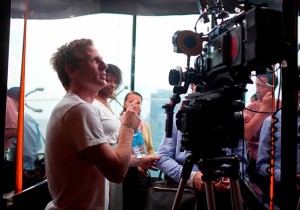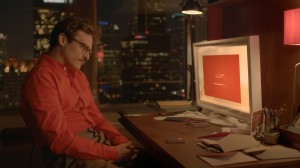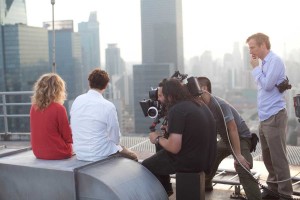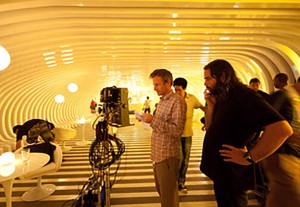
With the ubiquitous nature of the digital toolbox, smaller-budgeted films are now melding the previously separated crafts of production design, visual effects and picture editing. Case in point is the current sci-fi love story Her, in which all aforementioned skill areas were implemented in conjunction to fabricate the illusion of a vaguely futuristic Los Angeles. Longtime postproduction supervisor Peter Mavromates served as Her’s visual effects producer.
“Even before I came on, they had location stills and an artist drew basic concepts,” Mavromates said of Her’s pre-production period in service of creating this imaginary world without a $200 million expense. “They were toying with ideas early on. One of the places they went to shoot is Shanghai with its groups of buildings — it could be LA with a modernist twist to it.”
Naturally, like many such contemporary projects, Her was shot and posted digitally. Since director Spike Jonze wished to populate his world with subtle references to the future, visual effects, combined with production design, were considered early in the process. “They were thinking (about visual effects) as early as scouting,” Mavromates said. “They were even looking at stuff after it was shot and thinking that they could change something slightly so that they could reflect that it was different than its period. This went on through pre-production and right till the end of post. It wasn’t the effects that drove the schedule.”
Given Jonze’s predilections for manifesting a future landscape, he consulted production designer KK Barrett (Oscar nominated this year) on how they would combine Los Angeles, Shanghai, original construction, and Mavromates’ effects to create a seamless universe within the film. “Spike and KK did not want to be so strong in what the look was that people would say (it took place in) an exact year,” Mavromates described. “It’s in the not-to-distant future. The concept behind that is it is a normal world, slightly different.”
 Beginning work in October-November of 2012, Mavromates’ major work on Her was finished in September of 2013. During production, Mavromates made sure his department was present at all stages. “Either myself or somebody else in the process would be on set because there’s a specific need,” he said. “When they were shooting downtown in Theo’s (Joaquin Phoenix) apartment, in night shoots, we shot reference material and stills. The great thing about digital technology is that you can go in and modify what you shot.”
Beginning work in October-November of 2012, Mavromates’ major work on Her was finished in September of 2013. During production, Mavromates made sure his department was present at all stages. “Either myself or somebody else in the process would be on set because there’s a specific need,” he said. “When they were shooting downtown in Theo’s (Joaquin Phoenix) apartment, in night shoots, we shot reference material and stills. The great thing about digital technology is that you can go in and modify what you shot.”
When principal photography wrapped in Shanghai and Los Angeles, Mavromates’ major tasks remained, all in the name of realizing Jonze’s particular vision. “What happens is when an assembly comes out right after principal, I have a copy of the movie that I’m breaking down on the shots I know about,” Mavromates explained. “When Spike is in the edit room, other notes come up. In a shot, we’re talking about adding buildings on this side. I’m updating my database with all of those. There’s also the added complication of structure and scenes that are in or out. Obviously, we’re on a limited budget. You don’t want to commit to anything that’s going to be expensive if there’s a chance it could come out of the movie.”
In a sign of potentially revolutionary methodologies in feature postproduction’s new fluid digital pipeline, Her’s key team brought a visual effects compositor into the editing room to work on monitor graphics. Christopher Doulgeris is credited on the film as “In-house Visual Effects And Motion Graphics: 1 Man Army.”
“Spike likes to try things out,” Mavromates commented. “By bringing (Doulgeris) in-house, he can try different things. It’s an organic process for the computer screens. It’s becoming less and less unique. When Marvel do their movies, they have a big in-house team next door to editing.”
With large-scale effects films, sometimes requiring 1000 or more visual effects shots, hiring multiple visual effects vendors has become commonplace. Thus, in a smaller-scale film such as Her, having an in-house artist is merely logical, according to Mavromates. “In our movie, the number of shots that had to have work done on them is 200 or so,” he said. “With Spike, and (when) I work with David Fincher, we have somebody in-house that’s doing the smaller effects shots. You have this added benefit of trying things with a soft composite.”
Into this realm of adding visual effects elements to existing production shots, Her’s team added compositing elements to the list of tasks executed by assistant editors. “By having a compositor in-house to do the easier jobs, you have someone to do higher-level temp work,” Mavromates said, illuminating how polished temporary effects shots can be crucial to the film’s reaction from producers or early audiences. “If you go out and test screen, if you have stuff that takes you out of the moment, how much of your score is affected by that?”
 Through postproduction, Mavromates would enhance shots that might not have been conceived as effects shots during production — this comes in stark contrast to planned effects shots which, in the past, were often referred to as background plates into which a new effects element would be composited. In Her, given the state-of-the-art in digital imaging technology, Mavromates had no such problem with a lack of pre-conceiving many of its effects shots. “We decided to put some buildings outside of Theo’s office when he’s working on his computer,” he revealed. “The subtle thing like that to suggest that there’s tall buildings everywhere. These tools are getting so sophisticated now, it’s less and less of an issue. It seemed that it was a simple thing to do in that particular case. When you are on a small budget, you can enhance something for not a lot of money.”
Through postproduction, Mavromates would enhance shots that might not have been conceived as effects shots during production — this comes in stark contrast to planned effects shots which, in the past, were often referred to as background plates into which a new effects element would be composited. In Her, given the state-of-the-art in digital imaging technology, Mavromates had no such problem with a lack of pre-conceiving many of its effects shots. “We decided to put some buildings outside of Theo’s office when he’s working on his computer,” he revealed. “The subtle thing like that to suggest that there’s tall buildings everywhere. These tools are getting so sophisticated now, it’s less and less of an issue. It seemed that it was a simple thing to do in that particular case. When you are on a small budget, you can enhance something for not a lot of money.”
Elaborating on his postproduction modus operandi, Mavromates noted that often pre-planning effects shots can hamper a director, a necessity that has largely disappeared on smaller sets. “You are not over-thinking how you are shooting the actor,” Mavromates detailed. “When shots become effects shots, you can over-think it and make the camera static. I’d rather not make compromises because it’s an effects shot. In the last five years, the tracking abilities of the software [has become] just incredible. Now, I’m not worried. You can have somebody like Spike who works handheld but add something (later) to the background.”
Throughout the entire process, Mavromates needed to keep his shots and additions to the film within the allotted effects budget. “I have my breakdown going, and I’m estimating every shot,” he remarked. “It’s a guesstimate based on shots that I’ve done on other projects that are similar and the number of hours I think it’s going to take. Vince Landay (producer) gave me a reasonable number to work with. I was tracking it day by day to see that we were still going to be able to complete it for the number that I thought it was going to take.”
 Reflecting upon the project, Mavromates explained that Her’s approach to visual effects was, in the end, unique and understated compared to other films. “A lot of effects are being used in a way that you are not even supposed to know,” he said. “Spike has a curiosity to see things in different ways, and his overall approach to filmmaking has a lot of that in it. How much is pre-visualized, and how much is found after the fact? Spike walks around looking for opportunities all the time. The map is roughly sketched out. He turns to KK (Barrett) and asks, ‘What if we do that?’”
Reflecting upon the project, Mavromates explained that Her’s approach to visual effects was, in the end, unique and understated compared to other films. “A lot of effects are being used in a way that you are not even supposed to know,” he said. “Spike has a curiosity to see things in different ways, and his overall approach to filmmaking has a lot of that in it. How much is pre-visualized, and how much is found after the fact? Spike walks around looking for opportunities all the time. The map is roughly sketched out. He turns to KK (Barrett) and asks, ‘What if we do that?’”
In its final form, with Her’s carefully combined aspects of urban Shanghai and Los Angeles, and the interweaving of production design, locations, and effects shots, much of the film’s innate texture might be rendered invisible to the lay audience. “The way Spike does his movies, it doesn’t feel like an effect,” Mavromates stated. “Sometimes you think you’re going to need an effect to do something, but Spike just drops the actors in from out of frame. It’s so against the grain in many ways.”





